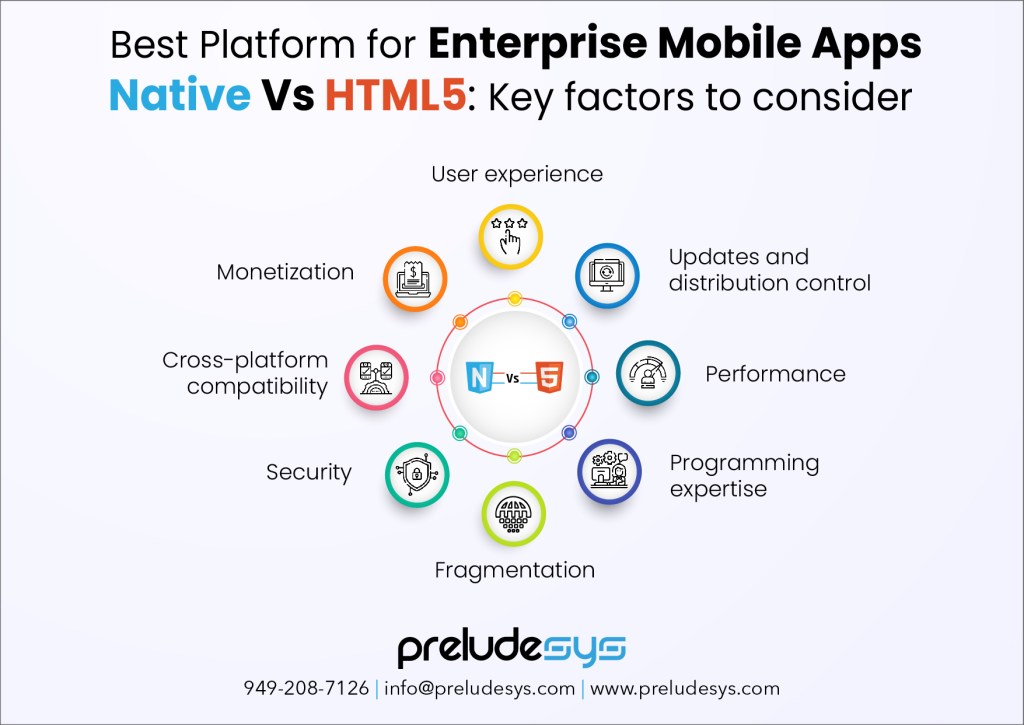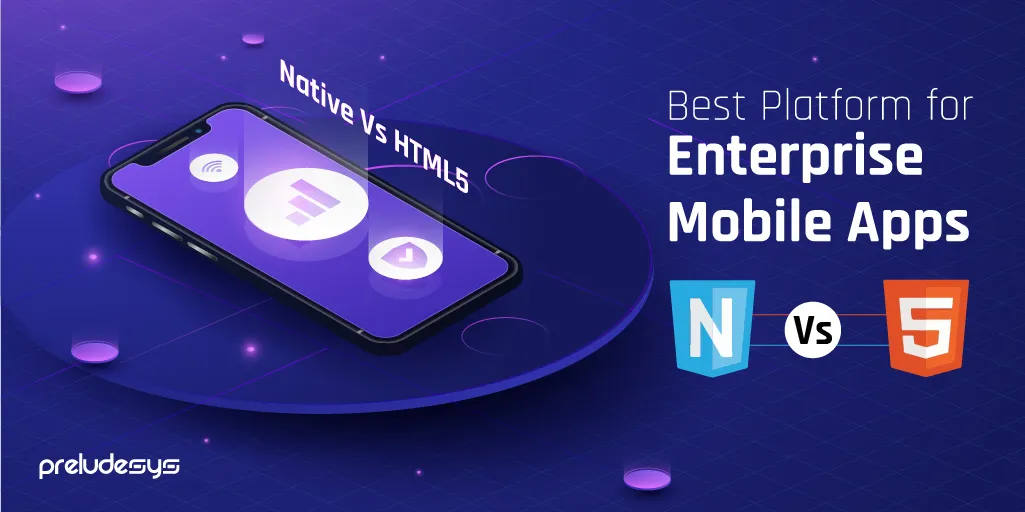Mobile app development for enterprises has changed dramatically in recent years. With businesses spanning industries requiring specialized applications to meet modern demands, the need for robust, scalable, and efficient mobile platforms has never been greater. Today, as newer technologies are developed and use cases are identified, enterprise-level applications’ needs are also growing. Almost every industry and sector has specialized applications to address problems and hurdles. Whether you aim to improve customer engagement, boost workforce productivity, or streamline operations, selecting the right app platform can define the success of your project.
Enterprises now have more options than ever, each with its own benefits and limitations. So, how do you choose?
In this blog, we’ll look at the fundamental differences between the platforms and their pros and cons, which will help you make the right choice for mobile app development.
What are Native Apps?
Native mobile apps are developed specifically for a single platform—either iOS (using Swift or Objective-C) or Android (using Kotlin or Java). This approach offers unmatched performance and deep integration with device hardware and operating system capabilities.
Pros:
- Best Performance: Native apps are optimized for the specific OS, which allows them to offer faster performance and better responsiveness.
- Full Access to Device Features: These apps can fully utilize device features such as GPS, cameras, microphones, and sensors, making them ideal for complex functionalities.
- User Experience (UX): Native apps generally provide a superior user experience due to their direct integration with the platform’s UI elements and standards.
Cons:
- High Development Cost: Building separate apps for iOS and Android increases development time and cost.
- Maintenance Overhead: Maintaining two codebases requires more resources and longer update cycles.

Mobile App Development – React Vs HTML5
Every technology has its own set of positives and limitations. Also, every app framework has its own set of best use cases.
So how do React and HTML5 mobile app development differ from one another?
Why React Native Apps?
Pros
- Solid UX
React Native mobile apps offer a high-performing user experience that is immersive and can withstand modern usage demands.
- Integration of Sensors
Native mobile apps take advantage of the modern mobile device’s advanced sensors (GPS, proximity sensor, gyroscope, etc.) and imaging capabilities to offer a state-of-the-art immersive experience.
- Harness OS Capabilities
Mobile apps developed on React native platforms are more capable of utilizing the full range of capabilities of Android and iOS.
- Monetization
The ability to monetize mobile apps is a huge benefit for developers and brands. React native app monetization models support the developer and can be found in abundance across the major app stores – Apple App Store & Google PlayStore
Cons
While React Native mobile apps seem to be the undisputed future, it has its own set of limitations.
- Require specialized React experts for development and quality check
- React does not come with reusable codebase
- Applications developed on React is usually heavier in size
Why HTML5 Apps?
Pros
- Cost-Effective
HTML5-based mobile apps leverage the power of the web. Its ‘write once and deploy anywhere’ nature has proven to be highly cost-efficient.
- Cross-Platform Compatibility
The ease and cost-efficiency of deploying HTML5 apps in cross-platform environments offer greater flexibility than react-native counterparts.
- Direct Distribution
HTML5-based mobile apps can be distributed directly to consumers. It does not require third-party platforms (Apple AppStore or Google PlayStore) to distribute.
- Offline Capabilities
A big positive of HTML5 mobile apps is their ability to offer a rich offline experience using an application cache.
Cons
Even though HTML5 mobile apps are easier to build, distribute, and maintain, it has their shortcomings.
- HTML5 recall functions are in no way close to that of React
- The language is still in the mid-development stage
- Open-source platforms are more prone to security threats
Other Options
Traditionally, the debate has revolved around Native apps (built specifically for iOS or Android) versus HTML5-based apps. However, the development landscape has evolved, and modern frameworks like React Native, Flutter, and Progressive Web Apps (PWAs) now offer compelling alternatives.
Flutter Apps:
Flutter, developed by Google, has become a strong competitor to React Native. It offers a powerful UI toolkit that allows for building natively compiled applications for mobile, web, and desktop from a single codebase. Unlike React Native, Flutter uses Dart as its programming language.
Pros:
- Beautiful UI Design: Flutter’s widget-based framework allows developers to create highly customized, aesthetically pleasing UIs consistent across platforms.
- High Performance: Compiled into ARM code, Flutter apps offer performance almost on par with fully native applications.
- Cross-Platform: Like React Native, Flutter allows cross-platform development with a single codebase.
- Hot Reload: Developers can instantly see changes in the app without recompiling the entire codebase, speeding up the development process.
Cons:
- Larger App Size: Flutter apps tend to be slightly larger than React Native or native apps.
- Learning Curve: Flutter uses Dart, which can be unfamiliar to developers who are used to JavaScript or other more popular languages.
Progressive Web Apps (PWAs):
Progressive Web Apps (PWAs) represent the evolution of HTML5 apps, offering a more app-like experience in the browser. PWAs combine the best web and mobile apps and can be installed directly from the browser to the home screen.
Pros:
- Cross-Platform: Like HTML5, PWAs work across any device with a browser and provide an app-like experience.
- No App Store Requirements: Users can install PWAs directly from the web, removing the need for app stores.
- Offline Capabilities: PWAs use service workers to provide offline access to certain functionalities.
- Faster Load Times: PWAs are optimized for speed, with faster loading times than traditional web apps.
Cons:
- Limited Native Functionality: PWAs still have limited access to system features and sensors compared to native apps or React Native/Flutter.
- Browser Compatibility: Not all browsers support every PWA feature, which can cause inconsistent performance across devices.
Choosing the Right Platform for Your Enterprise Mobile App
The right platform for your enterprise mobile app depends on several factors, including:
- Performance Requirements: If high performance and full access to device features are critical, native apps or Flutter are your best options.
- Cost and Development Speed: If you need to deploy apps quickly and cost-effectively across multiple platforms, React Native or Flutter are great choices.
- Web-First Approach: If your app doesn’t require native features and prioritizes web access, consider HTML5 or Progressive Web Apps (PWAs).
Develop Enterprise Mobile Apps with PreludeSys
Are you looking for professional assistance to develop an enterprise-level mobile application with reliable security features?
PreludeSys is a name synonymous with quality app development and digital transformation solutions. We’ve been a long-standing Microsoft Gold Partner and delivered digital solutions to countless organizations over the years. For any query or consultation regarding app development and related services, feel free to connect with us anytime.









